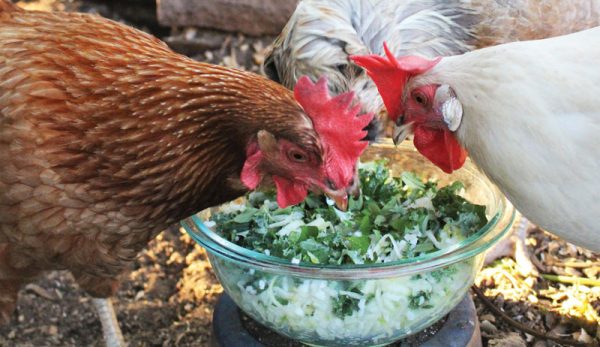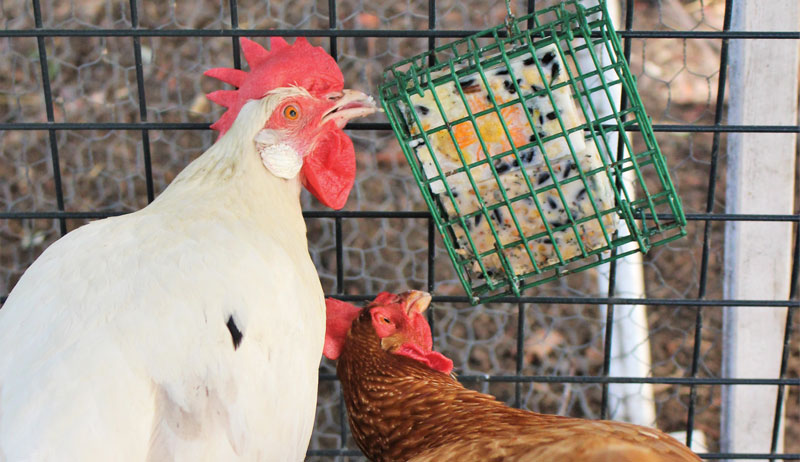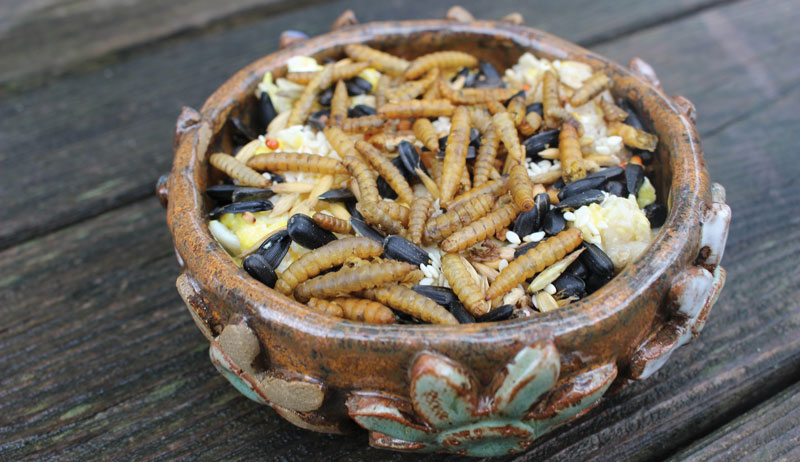
My family and I wanted chickens for years, but it never seemed like the right time. Once the spring of 2020 rolled around and all travel plans were canceled, we decided to get our own flock established. We were all home more than ever before and finally had the time to invest in such a project—including making and serving tasty treats for a new flock of chickens.
We live just outside of Minneapolis, Minnesota, and our home is in a residential area, which limits the number of chickens we can have. The city ordinance only allows three hens and no roosters (unless your neighbors don’t complain, which they did).
So, we have three hens—an Easter Egger, a Gold Star (a hybrid between a Light Sussex and Rhode Island Red) and a California White.
All breeds were decided upon by what their adult weight would be (our space is limited) and by their cold hardiness (we often get negative winter temperatures). Between the three hens, we get nearly 800 eggs per year, which is more than enough for our small family.
With 800 eggs, we always have enough extra to share with family, neighbors and friends.
Personality Plus
Before owning our small flock, I had no idea that chickens had such personalities. Even from the first day they hatched, they had distinct personality traits.
Phyllis was the sweet, most lovable chick. Smarty Pants was much smarter than the others (she was born one day earlier, and it showed). And Little B. was—well, you get the point. They’ve become a part of our family.
I enjoy their “help” in the gardens and their silly chicken antics. Smarty Pants loves to sneak into my landscaped mulched areas when I’m not looking and scratch around, even though she knows it’s off limits to her. Little B. loves to hop up the ladder of my daughter’s swing set and take in the view from the highest points, and Phyllis loves to walk into my gardens and take a quick bite here and there of my kale, chard, broccoli and cauliflower.
Phyllis thinks she’s being sneaky, but the truth is that I don’t mind one bit and am happy to share.
I especially enjoy early mornings in the summer with them, before the sun rises and heats up everything. I let them out of their poultry pen, and they tour the gardens with me, while I enjoy a mug of coffee. Those mornings are my favorite.
Five of my favorite treats follow that we occasionally make for our adult chickens. Please note that treats are to be given in moderation, and hens shouldn’t have more than a couple tablespoons of treats per day.
Read more: Here are some more tasty treats that also encourage engagement in the coop.
Treat 1: Leftovers
Whenever we cook up a batch of organic rice, I always reserve a little for the hens. Then I mix in whatever chicken-friendly scraps I have and add whichever produce I need to use up, such as grated zucchini, chopped kale, chard or other leafy greens.
I continue adding in whatever I have on hand—unsalted nuts or seeds, chopped apples, mashed bananas or other fruit—and then I mix in some herbs. My hens especially enjoy oregano.
I stir it all together and top it off with some dried mealworms or dried fly larvae and some oyster shells. There is no measuring required for this recipe, just a little of this and little of that, and our chickens adore the yummy treats. Plus, it’s a great way to get rid of some kitchen scraps.
Treat 2: Fruit & Veggie Garland
Celebrate the holidays with your hens or celebrate “just because.” Start with good strong string or wire. Then find a tool to push through the fruit and vegetables. I made a large needle out of wire, but a screwdriver or large sewing needle would work as well.
Tie a knot in the string with at least a 6-inch tail and begin threading a variety of chicken-safe fruits and vegetables onto the garland. Cut larger produce into 2- to 3-inch chunks.
Keep the garland 18 inches or shorter so that it doesn’t get too heavy, then tie another knot, leaving at least a 6-inch tail. Attach the garland to the chicken wire/fencing, and watch the hens enjoy their special treat.
Be sure to keep an eye on the hens while they eat, and remove the string/wire once they are finished snacking. String is unsafe for chickens to consume.
Garland ingredients your chickens will love include treats such as Brussels sprouts, grapes, apples, zucchini, cucumber, lettuce, squash, strawberries or watermelon.
Treat 3: Suet Treat
For this homemade treat, use the following.
Ingredients
- 1 cup coconut oil
- 1/2 cup unsalted nuts, chopped (pine nuts, pecans, pistachio or peanuts)
- 1/2 cup unsalted seeds (sunflower, pumpkin, chia or sesame)
- 1/2 cup mixed, dried, unsweetened fruit (dried cranberries, apples, blueberries, apricots, raisins or bananas)
- 1/2 cup mix dehydrated vegetables and herbs (carrots, zucchini, oregano, basil or dried nontoxic flowers, such as marigold or calendula)
- 1 cup scratch mix

Preparation
In a medium-size bowl, mix dry ingredients together. Melt coconut oil in a small saucepan on low until liquid. Use a heat-safe glass or metal baking pan as the suet block mold (large enough to fit 3 cups of mix), and line with parchment paper.
I personally prefer to use silicone soap molds for my suet blocks (never used for soap-making, only suet), because the set suet bricks easily pop out without any trouble of lining them with parchment paper.
Fill the prepared mold with the dry ingredients, and slowly pour the liquid coconut oil over the mixture. Allow this to cool for many hours or move to the refrigerator to speed up the process.
The coconut oil will harden and turn white once completely cooled.
To serve, simply give the suet brick to the hens or hang it in a suet feeder. It’s best to avoid serving on very warm days, as the coconut oil will soften and melt.
Treat 4: Fermented Food
The first time I made fermented chicken food was when Phyllis cracked her beak. She couldn’t peck the way she normally did because it would induce bleeding. I decided to add water to her food and let it soak up overnight.
I quickly noticed the hens were extremely enjoying this softened food. Little did I know that I was not only making the food easier for my hens to eat but also making it more beneficial for them.
I learned in Anne Kuo’s book, The Beginner’s Guide to Raising Chickens, that by fermenting chicken feed, it allows the naturally occurring bacteria to unlock the grains—making their enzymes, proteins and nutrients more readily available for the body to absorb—just like in fermented foods that humans eat.
She goes on to say that studies show that fermented chicken feed has many benefits, including better intestinal health, stronger immune systems, shinier feathers, increased egg size, less smelly droppings and stronger disease resistance, including resistance to salmonella and E. coli.
I don’t ferment each meal for my chickens. However, I ferment 1 quart on a weekly basis and they very much appreciate it.
How to Ferment Chicken Feed for a Small Flock
Measure 2 cups of chicken feed into a clean quart canning jar. Add water until the feed is covered with at least 2 inches of water and stir well. Add more water as needed throughout day 1 so that the feed stays submerged.
Cover with canning jar lid and ring and tighten. Ferment at room temperature, ideally between 60 to 75 degrees F, and keep out of direct sunlight.
Ferment between 1 and 5 days.
Burp the jar daily: Unscrew the lid briefly to allow built up gas to release (and avoid possible jar breakage), then screw it back on tightly. It’s completely normal to see little bubbles or even foamlike bubbling occur at the top of the ferment.
Use a clean spoon to stir down the feed, as it will push up toward the mouth of the jar as it ferments.
The fermented feed may have a sour smell, which is another normal sign of fermentation. To serve, pour the fermented feed into a clean dish for your flock as-is, or stir in any chopped fruit, veggies, leafy greens, oyster shells or treats as you see fit.
Discard if mold is present.
Read more: Do chickens really need apple cider vinegar?
Treat 5: High-Protein Molting Mix
It’s obvious when my flock is approaching molting season because they begin instinctively trying to boost their protein intake. They search for bugs and worms in my landscaped gardens and spaces where they normally stay out of during the summer. They know many bugs hide within the mulch.

At this point, I help them by lifting pots and stones around the yard, so they can peck and scratch the soft soil full of insects that hide below. I also help them by making high protein snacks, such as this recipe.
This is another recipe that I generally don’t measure, I just add a little of this and a little of that. But here is the general outline that I follow.
Ingredients
- scrambled eggs
- garlic
- oats
- black oil sunflower seeds
- hard red winter wheat berries (or other mixture of wheat)
- brewer’s yeast
- dried grub worms (or dried black solider fly larvae)
- sesame seeds
Preparation
Cook one egg per every two hens, and scramble with coconut oil and one garlic clove, chopped.
Stir eggs into 1⁄4 cup cooked oatmeal. Mix in 1⁄4 cup high-protein wheat and seeds. Top with brewer’s yeast and grub worms.
Because we live in a residential area without too much space to roam, we like to jazz things up with different snacks and treats for the chickens. I especially like to incorporate treats in the winter, when our ground is covered in snow and frozen solid. The chickens need more food during these months because they’re using energy to stay warm, and treats do the trick!
More Information
Grow Some Herbs
Chickens love herbs, and they make a great treats for a small flock to snack on.
- Mint: Helps repel rodents and insects, safe for chickens to eat and is said to be calming for chickens.
- Oregano: Known to be a natural antibiotic and immune booster, additionally it’s a guard against a whole host of common chicken illnesses.
- Basil: Promotes a healthy respiratory system and a healthy immune system overall.
- Lavender: Said to be a natural stress reliever and also an insect repellent. Can be chopped into food fresh or used dried.
This article originally appeared in the January/February 2022 issue of Chickens magazine.




